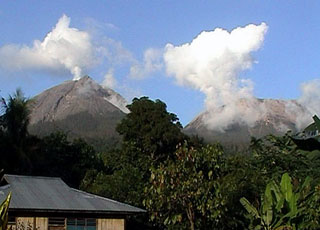Report on Lewotobi (Indonesia) — 26 June-2 July 2024
Smithsonian Institution / US Geological Survey
Weekly Volcanic Activity Report, 26 June-2 July 2024
Managing Editor: Sally Sennert.
Please cite this report as:
Global Volcanism Program, 2024. Report on Lewotobi (Indonesia) (Sennert, S, ed.). Weekly Volcanic Activity Report, 26 June-2 July 2024. Smithsonian Institution and US Geological Survey.
Lewotobi
Indonesia
8.542°S, 122.775°E; summit elev. 1703 m
All times are local (unless otherwise noted)
PVMBG reported that eruptive activity at Lewotobi’s Laki-laki volcano continued during 26 June-2 July. Multiple daily gray or white-and-gray ash plumes that were sometimes dense rose 50-1,000 m above the summit and drifted SW, W, and NW. An eruptive event that began at 1421 on 29 June lasted 10 minutes and 14 seconds based on the seismic data and produced a dense ash plume that rose around 900 m above the summit and drifted SW and W. According to a news article the Frans Seda Maumere Airport (60 km WSW) canceled flights from Kupang to Maumere on 2 July, though cancellations may have also occurred during the previous two days. Ashfall continued to impact residents in areas to the S and SW including Hokeng Jaya (4 km NW), Klatanlo (5 km NW), Persiapan Padang Pasir, Boru (8 km WNW), Pululera (6 km NW), Goloriang, Wotupudor, and Kumaebang. The Alert Level remained at 3 (the second highest level on a scale of 1-4) and the public was warned to stay outside of the exclusion zone, defined as a 3-km radius around both Laki-laki and Perempuan craters, 4 km to the NNW and SSE of Laki-laki.
Geological Summary. The Lewotobi edifice in eastern Flores Island is composed of the two adjacent Lewotobi Laki-laki and Lewotobi Perempuan stratovolcanoes (the "husband and wife"). Their summits are less than 2 km apart along a NW-SE line. The conical Laki-laki to the NW has been frequently active during the 19th and 20th centuries, while the taller and broader Perempuan has had observed eruptions in 1921 and 1935. Small lava domes have grown during the 20th century in both of the summit craters, which are open to the north. A prominent cone, Iliwokar, occurs on the E flank of Perampuan.
Sources: Pusat Vulkanologi dan Mitigasi Bencana Geologi (PVMBG, also known as CVGHM), Antara News, Antara News

